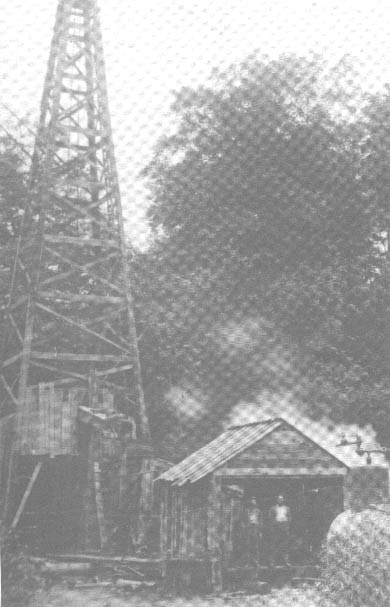YELLOW CREEK MEMORIES - Recollections Of Mary B. Carpenter

Evening in Yellow Creek Valley
I was born on Yellow Creek, Calhoun County, on March 21, 1909 in a building formerly known as the Rhoda Post Office. This building stood under the bank from the Taylor Cemetery; where is now a small white house located practically where the old post office stood.

Mary Bower Carpenter
The Rhoda Post Office was of short duration; it was established on March 20, 1903 and was discontinued on September 14. 1907. The first postmaster was James E. Fleming, who served until 1904; George Washington Junior "General" Taylor was appointed postmaster in 1904 and served until 1907, at which time Thomas Henderson Richards was appointed and served until the post office was discontinued. The house was later occupied by the Mallory family.
My sister, Alma, was born in an old building which was formerly used for a "bit of the bubbly," and was forever afterward known as the "Speakeasy." This house was located on Snider Ridge beside the house owned by "Uncle" Joe and "Aunt" Rose Snider; their daughter Zillie still lives at the home place (1980).
I was only two when Alma was born, but I well remember the occasion. I remember how the old house was built with a back porch high off the ground; this porch was just off the kitchen. I remember Agnes, daughter of Uncle Asa and Aunt Jane (Taylor) Laird, who stayed with us for a time after Alma was born.
We moved to Big Springs. The house we lived in was built against a bank, just below the Chestnut Grove Church, and quite near where Treavy Kimble later had the store and post office. While we lived there, Dad and Mom took us to an all day meeting at the church. After sitting for some time, I became restless and decided to go home.
I slipped out of church and was half way down the bank when one of the older children caught up with me and took me back. I was only three or four at the time. When Alma was about two years old, Mom went to milk the cow one day and left Delbert, age six, in charge of us younger children. "Deb" saw something on the mantle which took his eye and he climbed up on a chair to investigate. This was a tin can from which the rim had been removed and the can sharpened to use for cutting slaw; in getting off the chair, he dropped the can on Alma's face, cutting a deep gash in her cheek that left a scar for as long as she lived.
We didn't live near the church very long; Dad was working for Park Bowser, so we moved into one of his company houses at Beech Valley, and I believe that was where my sister, Gladys, was born in 1913. While living at the Bowser house, my brother Harley decided he wanted some tobacco, and he was afraid to use any of dad's tobacco, so he went to Alf Wilson's little store and snitched some. Harley was only nine or ten at the time.
Dad found out about it, and I guess the boys had an inkling that dad had learned about the incident, so, long before dark, all three of the boys (Harley, Howard and Delbert) got into one bed and pretended to be asleep; but that didn't stop the punishment. I saw dad approaching the bed with a razor strap and I ran and hid behind the door to escape seeing the boys get a whipping, and I cried harder than any of the boys. The next day, Dad sent Harley to Alf's store to apologize.
I was not yet six years old when we left Beech Valley, but I remember the Bowser girls. They had the same names, but reversed; one was Mary Margaret and the other was Margaret Mary. They were older than I, but they let me ride their bicycle. There were ten of us children, so we couldn't afford such things.
In 1915 Dad bought what was best known as the Metz farm. That is the place I remember best - probably because we could call it our own; then too many things happened while we lived there. The farm contained about 80 acres in two tracts, one in Sheridan District and one in Center District. The land was sold in 1879 by Perigrine Hays and wife Louisa to John Wesley and Lucy Ann Saunders Metz for $100. In 1884 Metz sold the farm to James F. Hodges. Hodges then sold the farm in 1885 to James and Hariett Metz for $500, who later sold it to their son Henry. Henry Metz sold it to Irvin and and Dessie Dye from Wetzel County in 1914 for $625. And later in 1914 the property was sold again to Charley and Lora Burrows Richards for $650. In 1915 the property was sold to my parents, Claude Monroe and Martha Jane Taylor Bower for $800. I believe the farm is now owned by an oil company.
While we were living at the Metz Farm, between 1915 and 1923, a well was drilled near our house (Metz #2). A gas well was expected and there was a crowd gathered around to see the well come in, but when it did it was an oil gusher. I witnessed this when I was a small child. I will never forget seeing the oil shoot into the air. My sister use to take dad lunch and play around the well houses until time for him to quit work.

Metz Well #2
In the summer of 1920 or 1921, four members of our family had typhoid fever and we found the germs came from the water well. This must have been about July since Delbert was helping in the hay harvest when he became ill. He went to the house and went to bed and from that time on he didn't know anyone for several days.
The others who had typhoid, Dad, Harley and Gladys; Harley also had bronchial pneumonia. Harold was also ill and he got so he couldn't walk. The doctor didn't know what was wrong with him. Mother kept his legs in a bucket of water almost constantly, and he got so he could walk but was crippled. We are sure now he had infantile paralysis (polio); one arm was smaller than the other and his feet were somewhat crippled and for many years he had special shoes made.
I had to take care of the younger children a lot when I was young, while mom and the older children worked in the garden and cleared fields, worked the hay, etc. One day before Harold got sick, I took him down to the barn where we had a swing fastened to a limb of a tree and while swinging with him the limb broke and hit him on the head. I had a guilty feeling for a long time because I resented having to take care of him. I felt it was my fault for him becoming paralyzed, but of course I knew better later. When Harold was a little fellow he tried so hard to do the things his friends did; he fell down many times; my heart ached for him but of course there was nothing we could do except make his life as easy as possible.
How my mother ever got through that siege of sickness I will never know. Along with my caring for five, she did the laundry daily. My sister Maude was a young woman at the time and she was a great help.
We had a log house at the farm. There was a large living room with a big gas fireplace, a kitchen and dining room built together; a bedroom built the length of the house and a small attic room. The smaller boys Odus, Oley and Harold were all born at that house, making ten of us.
We had three beds in the long room with three in a bed, with the tenth sleeping with our parents. When we had company, one of us had to sleep with our parents...
Alma was sickly as a child. Mother thought she might have had TB...The rest of us babied her and when she claimed a new-born calf, we all agreed it was hers.